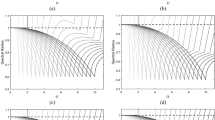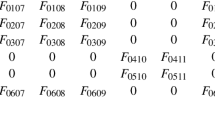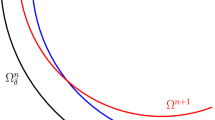Abstract
Homogenization of linear viscoelastic materials is possible using the viscoelastic correspondence principle (VCP) and homogenization solutions obtained for linear elastic materials. The VCP involves a Laplace–Carson Transform (LCT) of the material phases constitutive theories and in most cases, the time domain solution must be obtained through numerical inversion of the LCT. The objective of this paper is to develop and test numerical algorithms to invert LCT which are encountered in the context of homogenization of linear viscoelastic materials. The homogenized properties, as well as the stress concentration and strain localization tensors, are considered. The algorithms suggested have the following two key features: (1) an acceptance criterion which allows to reject solutions of unacceptable accuracy and (2) some algorithms lead to solutions for the homogenized properties where the thermodynamics restrictions imposed on linear viscoelastic materials are encountered. These two features are an improvement over the previous algorithms. The algorithms are tested on many examples and the accuracy of the inversion is excellent in most cases.
Similar content being viewed by others
References
Eshelby JD (1957) The determination of the elastic field of an ellipsoidal inclusion and related problems. Proc R Soc Lond Ser A 241:376–396
Hershey AV (1954) The elasticity of an isotropic aggregate of anisotropic cubic crystals. J Appl Mech 21:236–240
Hashin Z (1966) Viscoelastic fibre reinforced materials. AIAA J 4(8):1411–1417
Laws N, McLaughlin R (1978) Self-consistent estimates for the viscoelastic creep compliances of composite materials. Proc R Soc Lond A 359:251–273
Wang YM, Weng GJ (1992) The influence of inclusion shape on the overall viscoelastic behavior of composites. J Appl Mech 59:510–518
Rougier Y, Stolz C, Zaoui A (1993) Représentation spectrale en viscoélasticité linéaire des matériaux hétérogènes. Comptes Rendus Acad Sci 316(Série II b):1517–1522
Brinson LC, Lin WS (1998) Comparison of micromechanics methods for effective properties of multiphase viscoelastic composites. Composites Struct 41:353–367
Beurthey S, Zaoui A (2000) Structural morphology and relaxation spectra of viscoelastic heterogeneous materials. Eur J Mech A/Solids 19:1–16
Turner PA, Tomé CN (1993) Self-consistent modeling of visco-elastic polycrystals: application to irradiation creep and growth. J Mech Phys Solids 41(7):1191–1211
Li J, Weng GJ (1997) A secant-viscosity approach to the time-dependent creep of an elastic-viscoplastic composite. J Mech Phys Solids 45(7):1069–1083
Masson R, Zaoui A (1999) Self-consistent estimates for the rate dependent elastoplastic behaviour of polycrystalline materials. J Mech Phys Solids 47:1543–1568
Brenner R, Masson R, Castelneau O, Zaoui A (2002) A “quasi-elastic” affine formulation for the homogenised behaviour of nonlinear viscoelastic polycrystals and composites. Eur J Mech A/Solids 21:943–960
Lévesque M, Derrien K, Mishnaevsky L, Jr, Baptiste D, Gilchrist MD (2004) A micromechanical model for nonlinear viscoelastic particle reinforced polymeric composite material–undamaged state. Composites Part A Appl Sci Manuf 35(7–8):905–913
Biot MA (1954) Theory of stress–strain relations in anisotropic viscoelasticity and relaxation phenomena. J Appl Phys 25(1):1385–1391
Bouleau N (1992) Interprétation probabiliste de la viscoélasticité linéaire. Mech Res Commun 19:15–20
Bouleau N (1999) Viscoélasticité et processus de lévy. J Potential Anal 11(3):289–302
Hill R (1965) Continuum micro-mechanics of elastoplastic polycrystals. J Mech Phys Solids 13:89–101
Mori T, Tanaka K (1973) Average stress in matrix and average elastic energy of materials with misfitting inclusions. Acta Metallurgica Materialia 21:597–629
Walpole LJ (1981) Elastic behavior of composite materials: theoretical foundations. Adv Appl Mech 21:169–242
Bornert M, Bretheau T, Gilormini P (2001) Homogénéisation en mécanique des matériaux 2 – Comportements non linéaires et problèmes ouverts. Hermès Science Publications, Paris
Gavazzi AC, Lagoudas DC (1990) On the numerical evaluation of Eshelby’s tensor and its application to elastoplastic fibrous composites. Comput Mech 7:13–19
Davies B, Martin B (1979) Review – numerical inversion of the Laplace transform: a survey and comparison of methods. J Comput Phys 33:1–32
Schapery RA (1962) Approximate methods of transform inversion for viscoelastic stress analysis. In: Proceedings of the 4th US national congress on applied mechanics, vol 2, pp 1075–1085
Cost TL, Becker EB (1970) A multidata method of approximate Laplace transform inversion. Int J Numer Methods Eng 2:207–219
Press WH, Teukolsky SA, Vetterling WT, Flannery BP (2001) Numerical Recipes in Fortran 77 : the art of scientific Computing. Cambridge University Press, Cambridge
Lévesque M (2004) Modélisation du comportement mécanique de matériaux composites viscoélastiques non linéaires par une approche d’homogénéisation. PhD thesis, École Nationale Supérieure d’Arts et Métiers, Paris In English, download at pastel.paristech.org/archive/00001237/
Masson R (1998) Estimations non linéaires du comportement global de matériaux hétérogènes en formulation affine: application aux alliages de zirconium. PhD Thesis, Ecole Polytechnique, Paris
Author information
Authors and Affiliations
Corresponding author
Rights and permissions
About this article
Cite this article
Lévesque, M., Gilchrist, M.D., Bouleau, N. et al. Numerical inversion of the Laplace–Carson transform applied to homogenization of randomly reinforced linear viscoelastic media. Comput Mech 40, 771–789 (2007). https://doi.org/10.1007/s00466-006-0138-6
Received:
Accepted:
Published:
Issue Date:
DOI: https://doi.org/10.1007/s00466-006-0138-6




